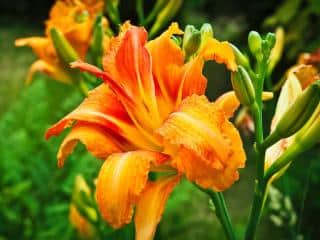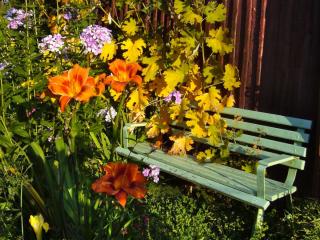

Daylily is a beautiful perennial that belongs to the Liliaceae or lily family. It blooms in a wide range of colorful flowers.
Since it is hardy and requires no care at all, it is ideal for those who want an easy garden to care for.
Daylily fears neither cold nor drought and will adapt to any soil type with ease.It can stay in place for years. Its petals are edible and add color to summer mixed salads. To sum it up, it’s the perfect garden flower!
 Daylily has long inspired horticulturists. Since Hemerocallis arrived in the Western hemisphere in the XIXth century (it is native to Asia and Central Europe), they’ve hybridized it incessantly to produce thousands of cultivars. As a result, today, a vast range of choices is available, from tiny plants that are ideal for ground cover to larger specimens that will form a backdrop at the back of your flower beds and under trees.
Daylily has long inspired horticulturists. Since Hemerocallis arrived in the Western hemisphere in the XIXth century (it is native to Asia and Central Europe), they’ve hybridized it incessantly to produce thousands of cultivars. As a result, today, a vast range of choices is available, from tiny plants that are ideal for ground cover to larger specimens that will form a backdrop at the back of your flower beds and under trees.
The star-shaped flowers, often two-colored, offer infinite combinations both in simple or double form. Also called “lily of a single day”, they wilt away every evening to free space for new blossoms every day.
Plant your daylily at the beginning of spring or in fall in a wide hole, either in full sun or part shade. Backfill with mature compost if the garden is poor, or with sand if it’s very loamy, and mulch.
 Daylily pairs well with rose trees, it will garner their base with dense leafage. It can also add a touch of color under trees, or bejewel your flower beds. Keep a planting distance of 12 inches (30 cm) between specimens.
Daylily pairs well with rose trees, it will garner their base with dense leafage. It can also add a touch of color under trees, or bejewel your flower beds. Keep a planting distance of 12 inches (30 cm) between specimens.
Once you’ve planted your daylily properly, nothing more is required of you: simply removing old wilted leaves in spring is enough. Daylily doesn’t have many enemies, only one little bug (pea midge) occasionally threatens the bloom by laying its eggs in the floral buds. If you notice that the floral buds look swollen, open them to check that they don’t harbor pea midge maggots. If so, remove all the infected buds. If ever it happens again, change species: select a daylily that blooms later in the season, that will reduce any chance of it being infected.
APEI-Actualités. Laure Hamann